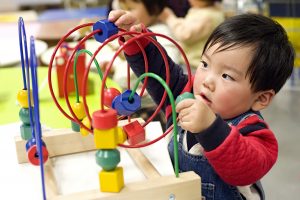This week, Beijing announced that married couples will be allowed to have three children, up from a cap of two set in 2016. The ruling Communist Party made the announcement following a Politburo meeting, though details on and a timeline for the new policy’s implementation remain unknown.
Previously, China had a strictly enforced a one-child policy, but as birth rates have continued to decline, the family planning policy change is part of an effort to reverse pressing demographic trends. Data from China’s latest census found that recorded births fell for a fourth straight year in 2020, with a national fertility rate of 1.3 newborns per woman, far below the 2.1 replacement rate. After the release of the census, Liang Jianzhang, an economics professor at Peking University, told the Global Times that “Without strong policy intervention, China’s new-born population is likely to fall below 10 million in the next few years, and its fertility rate will be lower than Japan’s, perhaps the lowest in the world.”
China’s shrinking labor force and expanding elderly population pose a clear challenge to its economic future. “Opening it up to three children is far from enough,” Huang Wenzheng, a demography expert with the Beijing-based Center for China and Globalization, told the New York Times. “Giving birth should be strongly encouraged. […] This should be regarded as a crisis for the survival of the Chinese nation, even beyond the pandemic and other environmental issues,” Huang added.
Still, this relaxation of restrictions on the number of children a family can have may not be enough to alter these trends. There are rampant concerns about a lack of daycare and long workdays, as well as the financial toll of raising children in modern China. In a nod to those issues, the party also indicated that it would improve maternity leave and workplace protections for women, pledging to make it easier for couples to have more children.
Some demographers have suggested that policies aimed at lowering education costs and adjusting educational concepts are needed to incentivize families to grow.
As in many developed and emerging economies, education for children is a major cost for families. Urban public education in China is determined by a family’s hukou — a household registration system that facilitates allocation of certain benefits, ranging from schooling to retirement benefits and healthcare. Well-off parents in top tier cities like Beijing and Shanghai will move to districts known for their quality schools. Housing costs in these districts are on par with median prices in major international cities like New York.
Without a hukou, families often turn to private schools with price tags that can range from 40,000 to 250,000 yuan per year ($6,270 to $39,190). Education costs are also not limited to the traditional classroom. Parents increasingly invest in their children’s future early, from private tutoring to a wide range of extracurriculars, be it a musical instrument or sport. An average family in Shanghai’s well-to-do Jingan district spent 840,000 yuan ($131,680) per child from birth until the end of junior high school, according to a 2019 report for the Shanghai Academy of Social Sciences; 510,000 yuan ($80,000) was dedicated exclusively to education. Meanwhile, lower-income families with annual incomes below 50,000 yuan ($7,840), spend more than 70 percent of their earnings on their child.
Health-related costs add to anxiety over education. Although prenatal tests and giving birth in public Chinese hospitals are typically covered by state health insurance, these facilities are resource constrained and more women are turning to private clinics. Private facilities can charge more than 100,000 yuan for deliveries ($15,700).
Child nutrition also comes with a steep sticker price. For families that can afford it, many feed their children imported milk formula, primarily from Australia and New Zealand, amid ongoing concerns over food safety in China. In 2008, the country faced a major scandal when milk and infant formula were contaminated with melamine to pass quality controls. More than 300,000 babies were poisoned, tens of thousands hospitalized, and a handful of babies died of kidney damage. The scandal decimated public confidence in domestic formula brands and Chinese families continue to trust foreign companies more than a decade later, despite the elevated cost. A can of baby formula may sell for more than $30 in China compared to $13 retail price in the United Kingdom.
China is not alone in facing slowing fertility rates. In fact, a host of other countries – including Australia, Estonia, Finland, Japan, and Singapore – have launched financial incentives as a strategy to combat dwindling population growth. These financial schemes, including baby bonuses and other benefits, are designed to assist families with child rearing costs and are often scaled depending on whether it is a family’s first, second, or third child. So far, authorities in Beijing have only taken the first step in easing restrictions.
“It is crucial to equalize the allocation of the resources for education and healthcare across rural and urban areas because the quality of China’s next generation of workers is as important as the quantity,” Fang Hanming, an economics professor at the University of Pennsylvania, told Nikkei Asia.
The public response to the new measure demonstrates that it may have missed its mark with younger generations, who are less interested in marriage and parenthood. Moreover, there was strong criticism from single women as the relaxed regulation extends only to married couples. Without greater incentives or structural changes to benefits and social expectations for women in the workforce, this new opportunity to have three children seems likely to remain a choice not taken.
































